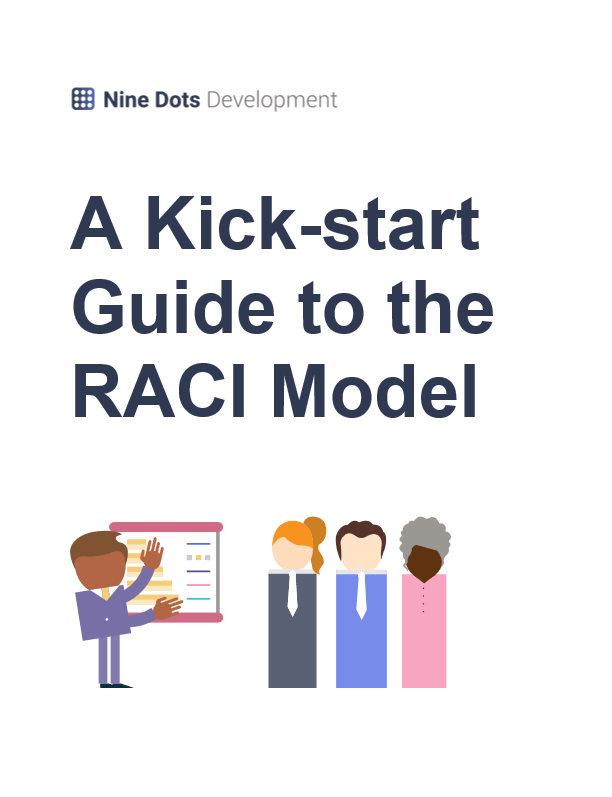Thursday 29 Jul 2021 Article
The TakeawayA Time-saving Model to Create Foolproof Systems
Protecting Your Precious Time Made Easy
Part 2 of 3
#SayingNo #Guide #ProtectingTime #RACI
The perfectly matched resource for this article...
Download Our Fantastic Kick-start Guide to the RACI Model!
Click the button below to download our Kick-start Guide to the RACI Model which includes an example of a completed RACI grid, a RACI template that can easily be used by any team in any organisation, and 3 common RACI pitfalls and how to avoid them.
Download guide!Playing catchup?
A Time-saving Model to Create Foolproof Systems
One of the biggest culprits of wasted time is having to re-do work - a recent study found that on average, UK workers spend 240 hours (equivalent to 30 working days) a year on rework.
The main reason for work having to be re-done is a lack of a structured, clear approach to completing projects. For any project, especially those which may be repeated in the future, it’s well worth planning and documenting how it should be done.
Having efficient systems in place helps save time by preventing rework, creating clarity of what needs to be done, and improving workflow and productivity.
Prospering Teams Use Systems
As well as helping save time by avoiding rework, using a systematic approach to completing projects or cross functional tasks brings a multitude of undeniable benefits, including:
- Improved consistency
When following a system, repeated tasks will always be done in the same way, so they should produce the same high quality of results every time - Greater efficiency
Having a structured approach to completing projects removes any uncertainty and confusion, allowing team members to crack on with their tasks - Decreased stress
Team members are extremely likely to be much less stressed when they have a clear process to follow and can plan their workload into their schedule in advance, instead of tasks being assigned to them last minute - More trust in teams
Using tools to organise and plan tasks makes everyone’s tasks visible to everyone else involved in the project helps foster more trust in teams, especially between managers and employees as managers can easily see if their staff are making substantial progress - No single point of failure
Documenting how projects should be completed means there is no single point of failure - everyone’s work could be done by somebody else if need be. This has always been important however, it is more important now than ever, especially in practical jobs, due to self-isolation rules meaning that staff could be out of office for 10 days with no prior warning.

Creating a Foolproof System
Systems and processes shouldn’t be reliant on individuals’ judgement calls; they need to clearly outline what needs to be done, who by, and when.
There are many different matrices and frameworks you can use to create systems; one that we commonly use at Nine Dots is the RACI model. The RACI model is designed to make sure that the right people are involved in the right way so that the task/project can be completed efficiently. The model assigns one of four roles to each team member/stakeholder for each task:
- Responsible
Who is responsible for completing the task?
Typically a member of staff - Accountable
Who is the decision maker and is responsible for ensuring that the task is completed correctly by the person responsible?
Typically the project manager - Consult
Who needs to be consulted for additional information or details?
Typically a subject matter expert - Inform
Who needs to be kept informed on the progress of tasks and the project as a whole?
Typically senior leadership
It’s important to note that only the roles ‘responsible’ and ‘accountable’ must be filled; not all projects will be complex enough to require consulting or informing others. This makes sure we know who is going to do the work and who is going to make sure the task is complete.
One of the key advantages of the RACI model is that whilst it provides clear structure and direction, it still allows for autonomy. The RACI model should be used as a guideline or framework, rather than a definitive to-do list. It lists the main milestones that make up a ‘project’ but doesn’t tell them exactly how to do it - the style of this can be left to the preference of the person completing the task.
Typically, RACI’s are created using a collaborative spreadsheet, such as Google Sheets. This not only means that the document will always be up-to-date rather than different people having different versions, it also allows you to plan the project better by providing you with a holistic view of what needs to be done and who needs to be involved. Using an electronic RACI grid rather than a physical one also means that the RACI is transferable between face-to-face working and remote working, which is essential in this new world.
Our RACI Success Story
Over the years, we have found RACIs to be a fantastic cross departmental/cross functional way of organising work that needs to be done. As aforementioned, we frequently use RACIs at Nine Dots, particularly when designing and implementing new apprenticeships. We recently launched our Level 3 HR Support apprenticeship and using a RACI made the process much simpler and more organised. We had an initial RACI planning meeting, weekly reviews to ensure everyone was on track, and then a final review to discuss what had gone well and what could be improved for next time. Overall, with the help of the RACI, the apprenticeship launch was a great success, delivered on time and with collaboration across multiple departments.
{{ADVERT}}
How to Implement RACIs in Your Team or Organisation
While this may seem like a relatively simple process, it’s crucial to use a framework/template so that essential steps aren’t missed.
We have created a fantastic Kick-start Guide to the RACI Model which includes:
- An example of a completed RACI grid
- A RACI template that can easily be used by any team in any organisation
- 3 common RACI pitfalls and how to avoid them
You can download this fantastic kick-start guide, by clicking here or clicking the button at the bottom of this article.
---
We hope that this article has brought to light how implementing foolproof systems can help you protect your precious time, and that you find the RACI model a useful tool.
Until next time...
Download Our Fantastic Kick-start Guide to the RACI Model!
Click the button below to download our Kick-start Guide to the RACI Model which includes an example of a completed RACI grid, a RACI template that can easily be used by any team in any organisation, and 3 common RACI pitfalls and how to avoid them.
Download guide!Missed an article?
More from Protecting Your Precious Time Made Easy
